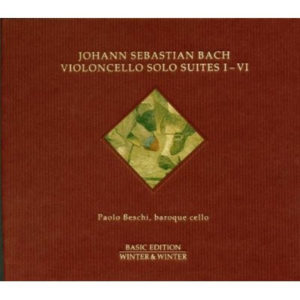
Paolo Beschi. Bach Cello Suites. Winter & Winter CD 910028-2.
Released 1998 as complete Suites recording. Suites 1-3 recorded 1996. Suites 4-6 recorded 1997-98. Also available in separate volumes.
Cello used for Suites 1-5 by Carlo Testore 1754
Cello used for Suite 6 by anonymous from 18th century.
No other information on set up but Baroque tuning used. (circa A=415 Hz)
Venue. Villa Medici-Giulini Briosco Italy.
Notes contain some details regards the recording and reproduction process.
Introduction.
The complete Suites version of this recording is presented in a very impressive hardback book style. There are neat slots for each of the CDs which are more durable than the usual plastic lugs. In contrast, the notes are somewhat brief and perfunctory with a timeline of Bach’s career rather than an essay. A bit different admittedly but I would have welcomed some insight from the performer about his interpretation.
The cellist.
Beschi born in Brescia rapidly decided to focus on Baroque music. He teaches at the Como conservatory. He is yet another Italian cellist who delivers a very individual take on the Suites in Baroque style. Elsewhere on the internet Beschi’s performance is described as:
passionate, intense, energetic, and extreme! We shall see!
The Recording.
This is certainly a fine recording. It is very clean and clear, with plenty of ambience but not clogged by too much reverberation. Finger board noises including the odd loud clunk are evident. There are also other mechanical noises from movement of the performer and bow. This may well be the result of close microphone techniques but I suspect is largely down to the performer’s playing style.
General comments.
Most of my review is confined to general comments which underpins the consistency of this performer’s interpretation. His playing IS passionate, intense and energetic. I have heard more extreme versions so don’t be put off by that adjective.
All the Preludes are taken at a very brisk pace but with a top-notch technique so that the polyphony is more clearly presented. Other movements, including Courantes are taken at more conventional pace.
The playing is rhythmic and has a clear pulse running through each movement. There is rubato but it is used musically with evenness of give and take that keeps the momentum going. Dynamics are used well to demonstrate light and shade and the voice of the cello used does vary tastefully. Having said that the intense and energetic voice predominates. Together with the use of gut strings the listener is given a hairy chest experience which may not be to everyone’s liking. Chords are sometimes given an extra dose of passion and energy so they swoop upwards in a grand gesture. I am surprised as to the amount of legato and tied notes played in Suites other than the Preludes. Another surprise is the marked restraint displayed in use of ornamentation. Bar the use of a few trills there is virtually none in stark contrast to fellow Italian Mauro Valli.
More specific comments.
Courantes were conducted at a surprisingly steady pace but played with marked spiccato passages. Sarabandes were poised and moved briskly but with plenty of space between notes. Certainly no sustained legato here! The fifth Suite Sarabande always a benchmark was played with great sensitivity and finesse. Allemandes were sedate and poised with moments of great delicacy. Gigues were not overly brisk but certainly rhythmic and played with gusto.
Conclusion.
I enjoyed this performance but would not include it in my top five, mainly due to its rather coarse sound. This I suspect is down to a combination of gut strings, forensic recording techniques and aggressive playing style.
Passionate, intense, energetic- yes, but extreme not quite!